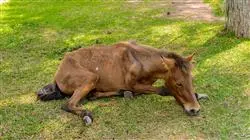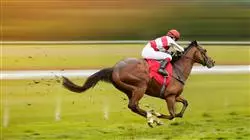University certificate
The world's largest faculty of veterinary medicine”
Introduction to the Program
A comprehensive update on Ruminant and Equine Production and Health with the most complete and effective educational program on the online market’’

Recent globalization and its impact on animal health and, therefore, public health, is a topic of worldwide interest. The increase in international trade and structural changes in nation states have led to the emergence and spread of global health phenomena that represent risks, challenges and opportunities for producers and consumers. This is turn has posed serious challenges for health agencies, professionals and educational institutions.
In line with the concept of One Health, the professionals will be able to identify issues arising in veterinary medicine that also impact public health (such as zoonotic diseases and antibiotic resistance) and food safety.
Students will develop specialist knowledge of the documentation to notify competent authorities and the procedure for sample collection and the operation of reference laboratories. Lastly, they will analyze the latest challenges and advances in animal health.
The Postgraduate certificate in on Ruminant and Equine Production and Health aims to provide advanced and multidisciplinary professional development in the field of Ruminant and Equine Health.
This program addresses the main strategies for dealing with any infectious or contagious diseases in equine species and ruminants, enhancing expertise and skills to diagnose, prevent and combat the main diseases of veterinary interest.
It provides an all-important multidisciplinary view of epidemiology, clinical practice and pathology, allowing students to develop a wide range of skills, insights and abilities that allow them to understand and apply theoretical knowledge in practice.
This Postgraduate certificate analyzes the concepts, definitions and tools that allow the professional to explore the main diseases that affect ruminants and equines through differential diagnosis, proper sampling for diagnosis, diagnostic techniques outlined for each infectious process and control measures to be applied for each disease.
Join the elite, with this highly effective educational program and open up new paths to career advancement’’
This Postgraduate certificate in Ruminant and Equine Production and Health contains the most complete and up-to-date program on the market. The most important features include:
- The latest technology in the form of online teaching software
- A highly visual teaching system, supported by graphic and schematic contents that are easy to assimilate and understand
- Case studies presented by practising experts
- State-of-the-art interactive video systems
- Teaching supported by telepractice
- Continuous updating and recycling systems
- Autonomous learning: full compatibility with other commitments
- Practical exercises for self-assessment and learning verification
- Support groups and educational synergies: questions to the expert, debate and knowledge forums
- Communication with the teacher and work for individual reflection
- Content that is accessible from any fixed or portable device with an Internet connection
- Supplementary documentation banks that are permanently available, even after finishing the course
A complete educational program that will allow you to acquire the most advanced knowledge in all areas of veterinary care for equines’’
Our teaching staff is made up of professionals from different fields related to Ruminant and Equine Production and Health. In this way we ensure that we deliver an educational update in line with objectives. A multidisciplinary team of professionals trained and experienced in different areas, will cover the theoretical knowledge in an efficient way, but above all, will bring practical knowledge from their own experience to the course: one of the factors that makes this program unique.
This mastery of the subject matter is complemented by the effectiveness of the methodological design. Developed by a multidisciplinary team of e-learning experts, it integrates the latest advances in educational technology. This way, you will be able to study with a range of comfortable and versatile multimedia tools that will give you the operability you need in your specialization.
The design of this program is based on Problem-Based Learning: an approach that conceives learning as a highly practical process. To achieve this remotely, we will use telepractice learning: with the help of an innovative interactive video system, and learning from an expert, you will be able to acquire the knowledge as if you were actually dealing with the scenario you are learning about. A concept that will allow you to integrate and fix learning in a more realistic and permanent way.
Benefit from the experience of practising professionals and the analysis of actual success stories, in this high-impact program"

With a methodological design based on proven teaching techniques, this innovative program uses a range of teaching approaches to allow you to learn in a dynamic and effective way"
Why study at TECH?
TECH is the world’s largest online university. With an impressive catalog of more than 14,000 university programs available in 11 languages, it is positioned as a leader in employability, with a 99% job placement rate. In addition, it relies on an enormous faculty of more than 6,000 professors of the highest international renown.

Study at the world's largest online university and guarantee your professional success. The future starts at TECH”
The world’s best online university according to FORBES
The prestigious Forbes magazine, specialized in business and finance, has highlighted TECH as “the world's best online university” This is what they have recently stated in an article in their digital edition in which they echo the success story of this institution, “thanks to the academic offer it provides, the selection of its teaching staff, and an innovative learning method aimed at educating the professionals of the future”
A revolutionary study method, a cutting-edge faculty and a practical focus: the key to TECH's success.
The most complete study plans on the university scene
TECH offers the most complete study plans on the university scene, with syllabuses that cover fundamental concepts and, at the same time, the main scientific advances in their specific scientific areas. In addition, these programs are continuously being updated to guarantee students the academic vanguard and the most in-demand professional skills. In this way, the university's qualifications provide its graduates with a significant advantage to propel their careers to success.
TECH offers the most comprehensive and intensive study plans on the current university scene.
A world-class teaching staff
TECH's teaching staff is made up of more than 6,000 professors with the highest international recognition. Professors, researchers and top executives of multinational companies, including Isaiah Covington, performance coach of the Boston Celtics; Magda Romanska, principal investigator at Harvard MetaLAB; Ignacio Wistumba, chairman of the department of translational molecular pathology at MD Anderson Cancer Center; and D.W. Pine, creative director of TIME magazine, among others.
Internationally renowned experts, specialized in different branches of Health, Technology, Communication and Business, form part of the TECH faculty.
A unique learning method
TECH is the first university to use Relearning in all its programs. It is the best online learning methodology, accredited with international teaching quality certifications, provided by prestigious educational agencies. In addition, this disruptive educational model is complemented with the “Case Method”, thereby setting up a unique online teaching strategy. Innovative teaching resources are also implemented, including detailed videos, infographics and interactive summaries.
TECH combines Relearning and the Case Method in all its university programs to guarantee excellent theoretical and practical learning, studying whenever and wherever you want.
The world's largest online university
TECH is the world’s largest online university. We are the largest educational institution, with the best and widest online educational catalog, one hundred percent online and covering the vast majority of areas of knowledge. We offer a large selection of our own degrees and accredited online undergraduate and postgraduate degrees. In total, more than 14,000 university degrees, in eleven different languages, make us the largest educational largest in the world.
TECH has the world's most extensive catalog of academic and official programs, available in more than 11 languages.
Google Premier Partner
The American technology giant has awarded TECH the Google Google Premier Partner badge. This award, which is only available to 3% of the world's companies, highlights the efficient, flexible and tailored experience that this university provides to students. The recognition as a Google Premier Partner not only accredits the maximum rigor, performance and investment in TECH's digital infrastructures, but also places this university as one of the world's leading technology companies.
Google has positioned TECH in the top 3% of the world's most important technology companies by awarding it its Google Premier Partner badge.
The official online university of the NBA
TECH is the official online university of the NBA. Thanks to our agreement with the biggest league in basketball, we offer our students exclusive university programs, as well as a wide variety of educational resources focused on the business of the league and other areas of the sports industry. Each program is made up of a uniquely designed syllabus and features exceptional guest hosts: professionals with a distinguished sports background who will offer their expertise on the most relevant topics.
TECH has been selected by the NBA, the world's top basketball league, as its official online university.
The top-rated university by its students
Students have positioned TECH as the world's top-rated university on the main review websites, with a highest rating of 4.9 out of 5, obtained from more than 1,000 reviews. These results consolidate TECH as the benchmark university institution at an international level, reflecting the excellence and positive impact of its educational model.” reflecting the excellence and positive impact of its educational model.”
TECH is the world’s top-rated university by its students.
Leaders in employability
TECH has managed to become the leading university in employability. 99% of its students obtain jobs in the academic field they have studied, within one year of completing any of the university's programs. A similar number achieve immediate career enhancement. All this thanks to a study methodology that bases its effectiveness on the acquisition of practical skills, which are absolutely necessary for professional development.
99% of TECH graduates find a job within a year of completing their studies.
Postgraduate Certificate in Ruminant and Equine Production and Health
.
At TECH Global University, we understand the importance of animal health and welfare in the field of agricultural production. For this reason, we have designed the Postgraduate Certificate in Ruminant and Equine Production and Health, a unique opportunity to acquire specialized and advanced knowledge in the care of these animals that are so important for our society. The ruminant and equine production sector plays a fundamental role in the economy and food supply. Professionals involved in this area must have up-to-date skills and knowledge to ensure the health, performance and welfare of the animals throughout their life cycle.
They must have up-to-date skills and knowledge to ensure the health, performance and welfare of the animals throughout their life cycle.
Why choose TECH Global University?
.
Our institution is recognized nationally and internationally for its academic excellence and innovation-focused approach. By joining TECH Global University, you will benefit from our state-of-the-art resources, expert professors in the field and a community of students committed to advancing agricultural production. The Postgraduate Certificate in Ruminant and Equine Production and Health will provide you with a broad understanding of key concepts related to animal production, health and management. You will learn about feeding and nutrition systems, animal management and welfare practices, reproduction and breeding techniques, as well as disease prevention and control strategies. Our teaching team is composed of experts in animal production and health, who will guide you throughout the course, sharing their experience and providing you with the necessary tools to excel in this field. In addition, you will be able to network with industry professionals and expand your network of contacts during your time at TECH Global University.







